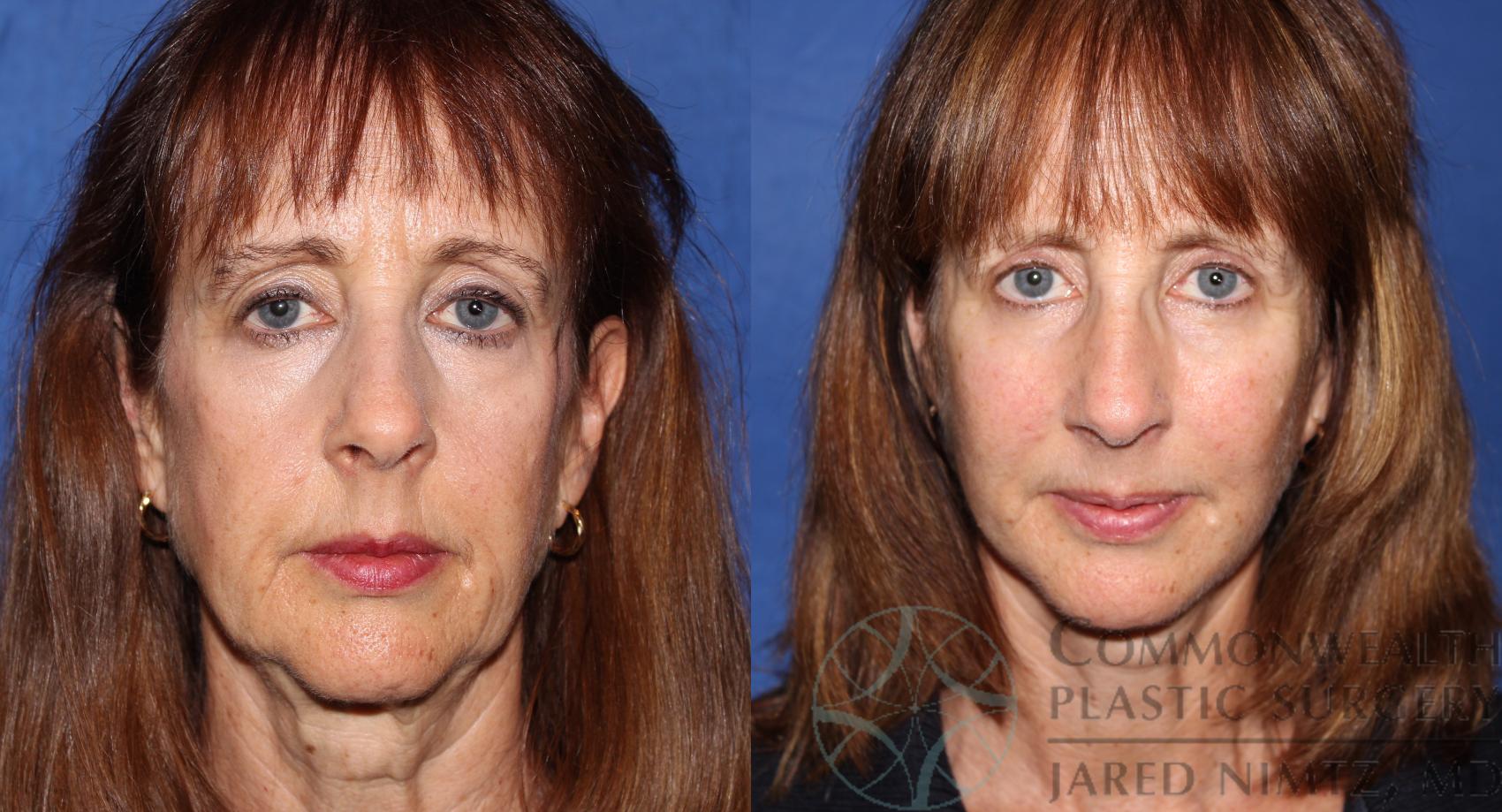Whether surgical or nonsurgical, a wealth of options are available for facial rejuvenation. At Commonwealth Plastic Surgery, we work closely with our patients to determine the best facelift options for them. That may be as simple as injectable wrinkle relaxers and fillers, as intensive as a traditional facelift, or as customized as a hybrid approach (à la our signature Lunch Hour Lift). Read on to learn more about the types of facelifts we offer and what you can expect from each.
Traditional Facelift
The traditional facelift revitalizes the lower two-thirds of the face to restore firmness to the cheeks and a more youthful contour to the chin and jawline. The procedure is frequently enhanced with a neck lift to address sagging skin and the vertical banding that occurs with age.
Some patients may also undergo liposuction if they desire a slimmer, more elongated face. Others may seek instead to add fat to the face to replenish the volume lost to aging. This procedure, called facial fat grafting, harvests the patient’s unwanted body fat and then redistributes it to the face and lips.
Traditional facelifts produce the most dramatic and extensive results. Accordingly, they also require the most extensive incisions as well as a longer recovery period than other facelift options (10 to 14 days for postoperative recovery; 6 months for the healing process to complete). However, traditional facelifts do have longevity on their side, with patients able to maintain their initial results for an average of 5 to 10 years.
Mini Facelift
As the name suggests, the mini facelift is an abridged version of the traditional procedure, offering smaller, more discreet incisions and a shorter surgical downtime (usually one week before patients can return to work). The procedure focuses on either correcting signs of aging in the midface or sagging and laxity in the chin and neck, with an emphasis on trimming and tightening excess skin rather than repositioning the deeper layers of muscle and connective tissue. The results of a mini facelift tend to last around 5 years—though, with adequate sun protection and a healthy lifestyle, patients can often enjoy their results for much longer.
Nonsurgical Rejuvenation
What is a nonsurgical facelift, you may ask? It’s a type of facial rejuvenation procedure that addresses skin laxity and visible signs of aging in a minimally invasive way. The recovery process for nonsurgical facelifts tends to be minimal, but results may require “top-up” treatments every few months to be maintained. Patients can pursue this route as an alternative to surgery or as a supplement to help extend their results.
Liquid Facelift
A liquid facelift is a cosmetic procedure that combines a neuromodulator such as BOTOX® with a dermal filler such as Juvederm®. Together, these injectables smooth wrinkles, relax expression lines, and restore youthful plumpness to the cheeks and lips. Patients in their 20s to 40s may pursue this procedure as a safeguarding approach against future aging, while older patients can enjoy a revitalized appearance without the strain of surgery. The results of a liquid facelift last between 6 to 12 months, so annual or semi-annual maintenance treatments are recommended.
Laser Treatment
CO2 laser skin resurfacing is most commonly known as an adjunct to facelift surgery, addressing superficial skin issues such as fine lines, rough skin texture, mild scarring, hyperpigmentation, and sun damage. However, it also improves the skin’s structure and elasticity, helping to tighten and firm the skin.
Laser results can be seen within the first few days as new, healthier skin emerges—but it may take 2 to 3 months for the results to develop fully. This skin tightening effect is not as dramatic as with a surgical facelift, but it’s an excellent option for those who want a nonsurgical treatment for mild skin laxity.
With proper attention to skin care and sun protection, you can enjoy the improvement in tone, texture, and color for several years.
The Lunch Hour Lift
Our most personalized facelift procedure, the Lunch Hour Lift, offers patients the best of both worlds: minimal surgery complemented with nonsurgical enhancements. The procedure typically involves a mini facelift to target the midface or neck. It can be combined with a liquid facelift—with or without facial fat grafting—or laser skin resurfacing, depending on the patient’s goals.
A popular variation of the Lunch Hour Lift involves facial liposuction paired with a skin-tightening procedure using Renuvion. This FDA-approved treatment uses heat to combat laxity in the chin and neck and does not need follow-up treatments to achieve its full results.
Whichever combination of surgical and nonsurgical treatments you decide on, the Lunch Hour Lift typically boasts a 4-to-7-day recovery period with beautiful, long-lasting results. To find out more about how a Lunch Hour Lift can transform your face, please check out our related blog post.
Interested in one of our facelift procedures? We’d love to hear from you! Please request a consultation or call us at (859) 277-9435.





Leave a Reply